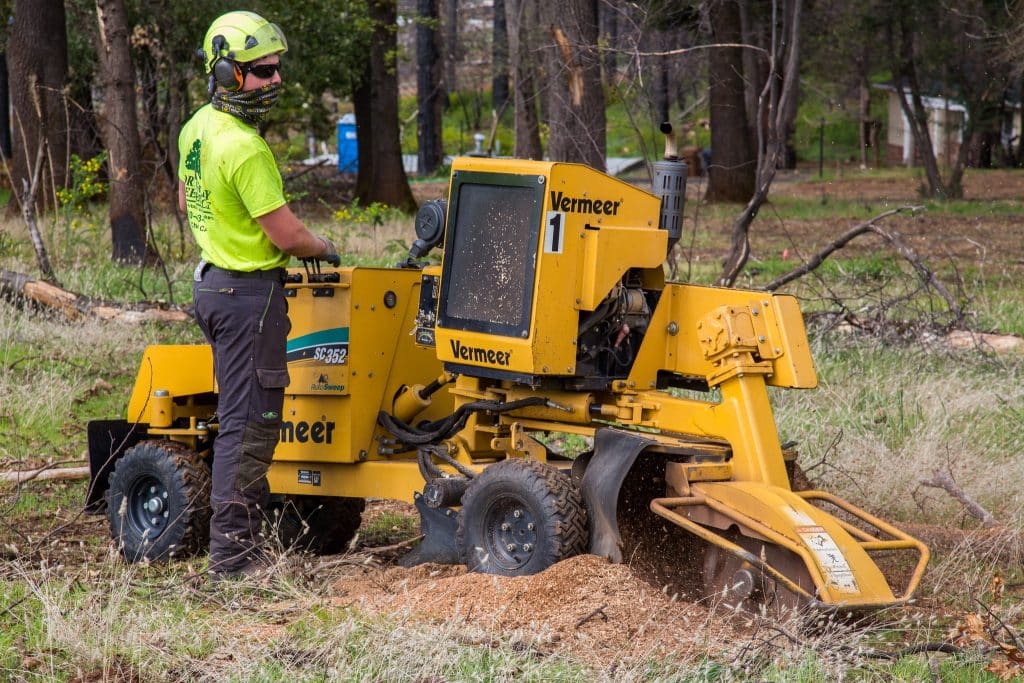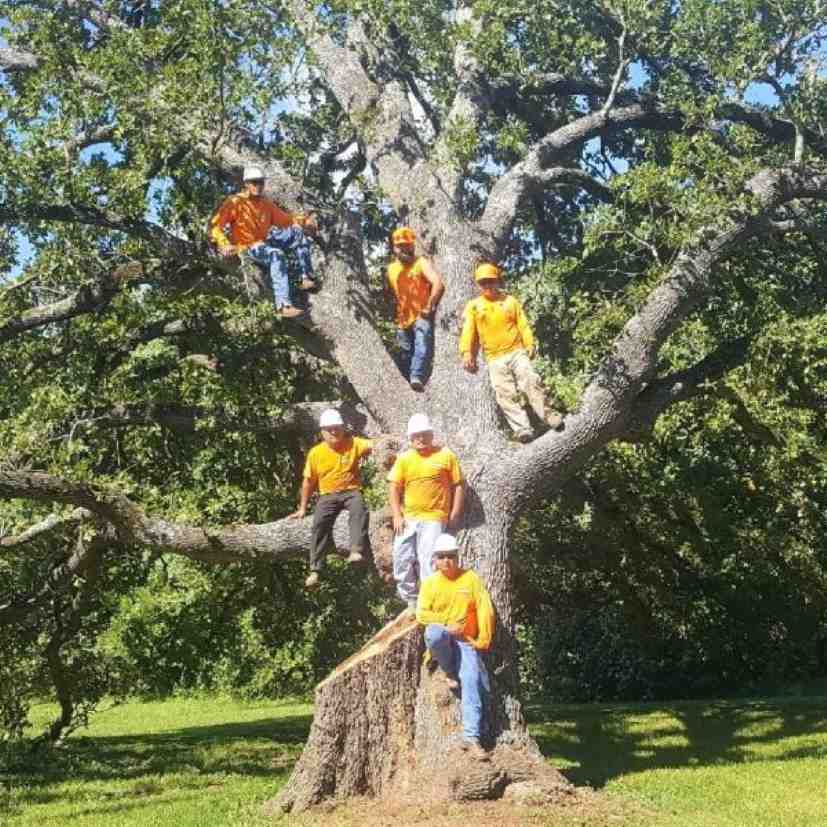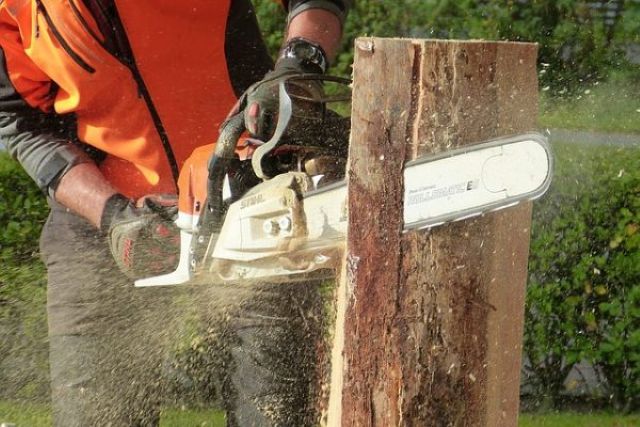If you’ve ever had a troublesome tree stump take up space in your yard, you’ve certainly wondered how long does it take to grind a stump. You’ve come to the correct place. In this comprehensive guide, we’ll walk you through the procedure, variables influencing the timing, and expert recommendations to make the task simpler. Whether you’re a DIY enthusiast or planning to hire a professional, this article has you covered.
What Is Stump Grinding?
A stump grinder is a heavy-duty piece of machinery featuring a rotating carbide-tipped steel wheel on its front, similar in appearance to an oversized circular saw blade.
This wheel is carefully positioned on the edge of the stump, and as it spins, it is moved from side to side, progressively grinding deeper into the stump with each pass. Ultimately, the entire tree stump, including the primary roots extending beneath it, is transformed into small wood chips through this grinding process.
Why Might You Opt for Stump Grinding?
Most individuals choose to grind a stump following tree removal for several reasons. Firstly, stumps left behind can be unsightly, negatively impacting the aesthetics of your landscape. Additionally, they pose a potential tripping hazard and safety concern, making removal essential.
Furthermore, if you plan to use the cleared area for planting or other purposes, stump grinding ensures a clean slate.
Moreover, when dealing with a tree that is diseased or infested with pests, stump removal helps contain the issue, preventing the spread of disease or pests to nearby vegetation. Lastly, it prevents the original tree from regrowing, saving you from future removal efforts.
How Long Does It Take to Grind a Stump?
Stump Size and Hardness
Stump size and hardness are critical parameters that can considerably affect the time required for stump grinding. To offer a more in-depth understanding:
Larger stumps, with broader diameters and higher heights, often need more time for thorough grinding. A tiny stump, such as one from a sapling, can take as little as 15 to 30 minutes to grind down. In comparison, removing a big oak tree stump may take many hours or even days. It is critical to note that the sheer volume of wood involved is a key time driver.
Another significant factor is the wood’s toughness. Trees with dense and strong wood, such as oak or hickory, present a greater challenge. Harder wood takes more time and effort to grind through softer wood like pine or spruce. So, while considering the time it takes to grind a stump, keep both size and wood density in mind.
The Type of Grinder
Professional stump removal services often use large-capacity grinders that are particularly built for fast and efficient operation. These powerful devices can drastically reduce the amount of time necessary.
If you prefer to do it yourself and hire a grinder, you may end up with smaller, less powerful equipment. This can make the job take longer, especially when dealing with bigger stumps.
The sort of grinder used might also have an effect on the job’s quality. A professional-grade grinder offers a smoother, more equal grind, whereas lesser equipment may leave uneven surfaces that need further effort.
Depth grinding
The depth to which you want to grind the stump is an important factor that determines the timeframe. Here is a more detailed explanation:
If you just need to grind the stump a few inches below the surface, it’s a short job. This amount of grinding is frequently suitable for simple landscaping tasks. However, if you wish to completely eliminate the stump by grinding it deeper into the ground, the operation would take substantially longer.
Depending on the size of the stump and the tools utilized, it might take a day or more to completely remove it. The depth of grinding also has an impact on the disposal of wood chips. The operator’s skill and competence are important in determining how long it takes to grind a stump. Expanding on this point:
Experience of operator
An experienced operator, whether professional or do-it-yourself, can perform more efficiently and successfully. They grasp the stump grinder’s subtleties, allowing them to maneuver it with accuracy.
Furthermore, competent operators can tackle unanticipated obstacles that may develop during the grinding process, such as concealed roots or stones, without substantial delays. Inexperienced operators may find themselves spending more time troubleshooting, thus extending the project’s timetable.
Accessibility
The accessibility of the stump site is an important but frequently disregarded aspect impacting the stump grinding schedule. Here’s a more in-depth explanation:
If the stump is in a difficult-to-reach location, the work may take longer to complete. Obstacles such as fences, buildings, or landscape elements might obstruct the movement of the stump grinder.
It takes longer to go around or over these barriers, set up the equipment, and finish the work. Furthermore, if the stump is in a difficult-to-reach position on your property, it might complicate the operation and lengthen the schedule.
Understanding these five critical factors: stump size and hardness, kind of grinder, depth of grinding, operator experience, and accessibility, provides a full picture of how different variables influence the time it takes to grind a stump.
By taking these variables and expert advice into account, you may better prepare for effective stump removal, whether you opt to do it yourself or hire a professional.
Tips for Efficient Stump Grinding
To make the stump grinding process smoother and more efficient, here are some expert tips:
Clear the Area: Remove any rocks, trash, or barriers from surrounding the stump to promote a safe and effective grinding procedure.
Mark the Stump: Mark the stump’s limits to guide the operator and ensure they grind exactly where needed.
Use Safety Gear: Whether you’re a DIY enthusiast or hiring a professional, always emphasize safety by wearing suitable gear such as safety glasses and ear protection.
Professional Help: For larger or more challenging jobs, consider hiring a professional stump removal service to ensure a quicker and safer process.
Post-Grinding Care: After the stump is ground, fill the hole with soil, and consider planting grass or a new tree in the area.
FAQS
What is the cost of stump grinding?
Stump grinding costs vary based on criteria such as stump size, location, and professional employed. On average, it might cost between $100 and $400 per stump.
Is it advisable to do your own stump grinding?
While DIY stump grinding is feasible, it is frequently safer and more effective to employ a professional, especially for bigger or more difficult stumps.
Can I plant a new tree in the same area where a stump was removed?
Yes, when the old stump is removed, you can plant a new tree in the same spot. Simply fill the hole with excellent dirt and plant according to the directions.
How deep should I grind the stump if I’m going to build anything or grow grass?
To create buildings, the stump may need to be ground several feet below the surface. A few inches below ground level is generally sufficient for sowing grass.
What becomes of the wood chips generated during stump grinding?
Depending on your preferences, the wood chips generated by stump grinding might be utilized as mulch or disposed of.
Conclusion
Finally, the time it takes to grind a stump is determined by a number of factors, such as the stump’s size, the type of grinder used, the depth of grinding, the operator’s expertise, and accessibility.
Understanding these aspects and following our professional advice will ensure a faster and more effective stump grinding process. Whether you choose to do it yourself or hire a professional, the final result will be a stump-free yard ready for new possibilities.




